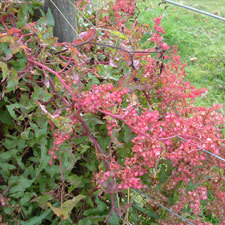 Climbing dock
Climbing dock
Common name: Climbing dock
Botanical name: Rumex sagittattus
Management programme: Advisory
Originates from South Africa and was introduced to New Zealand as an ornamental plant. It was naturalised in 1935.
Why is it a pest?
- Effective dispersal and fast growth rate allow it to scramble quickly over most plants to over 3m high.
- It invades regenerating habitats, bare and open sites, replaces low canopy, and prevents the establishment of native plant seedlings. It provides support for more aggressive invasive species.
Where is it found?
- Found in bush and shrubland margins, coastal areas, hedges, and wastelands. Prefers warmer conditions. The tubers flourish in crevices.
- Seeds and tubers are spread by wind and fresh or salt water, soil movement and vegetation dumping.
- Common and widespread in the Bay of Plenty.
What does it look like?
- Scrambling or low climbing perennial with kumara or beetroot-like woody tubers with yellow flesh. Flexible stems up to 3m long.
- Extensive, long, weak rhizomes.
- Hairless, reddish-green stems are ribbed, zigzagging and slender.
- Light green arrow-shaped leaves.
- Clusters of small, green-pink, or reddish flowers are produced at the top of the plant from November to March, followed by large masses of showy yellow-pink-crimson, flat, heart shaped capsules containing seeds.
- Seeds are dispersed by wing and germinate easily.
- No other climber has conspicuous pink seed capsules.
- In drought conditions it dies back to tubers.
What are the rules?
Advisory
The Bay of Plenty Regional Council does not enforce the control of advisory species. It is landowner/ occupier responsibility to manage these pests. Council may provide advice on how to manage or control these species if required.
How do you get rid of it?
Recommended:
- Dig out tubers and rhizomes, small sites only (spring – summer)
- Spray in summer with metsulfuron and penetrant. It is best to spray as a follow up after digging out tubers.
Tubers re-sprout after herbicide treatment and missed fragments will re-sprout after digging. Replant bare sites to minimise reinvasion.
CAUTION: When using any herbicide or pesticide, PLEASE READ THE LABEL THOROUGHLY to ensure that all instructions and directions for the purchase, use and storage of the product, are followed and adhered to.
Read more on pest control advice, information and regulations.
Images






